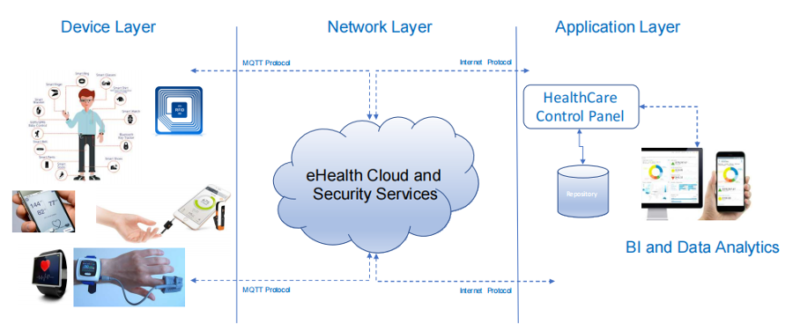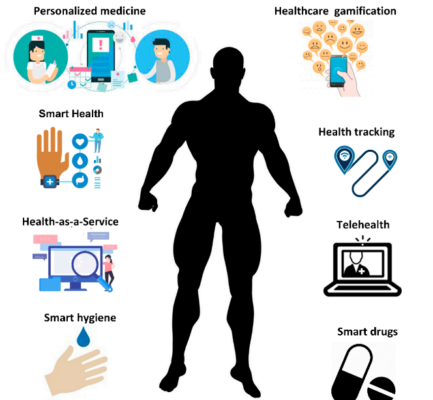The development of the internet of things is the core element of Industry 4.0 and continues to improve aspects of lives. We can see that the IoT has radically changed business processes, agriculture, transportation,… and many other domains which shows the high demand and applicability of IoT. A simple explanation for IoT is the network of devices that can exchange data with other devices through the Internet. Data from devices can be gathered and stored for analysis. IoT therefore can increase the automation level and remote monitoring. In this article, we will represent other applications of IoT when it comes to increasing the quality of life of its users via e-Health, assisted living, and e-Wellness.
e-health and e-Wellness

The healthcare industry can rely on IoT devices and technologies to reduce the cost, time and improve the quality of the existing system. The emergence of the concept of digital health or e-health is to specify the use of IoT in the health sector and provide it with cutting-edge resources to ensure more effective management and optimized diagnosis, in short, better patient care. This includes innovations in countless areas, such as doctor-patient communication, research, and hospital management.
Monitoring human health is necessary because it helps people know more about their bodies and may give them some clear observations of the status of their health. Some common parameters such as heart rate, blood pressure, blood oxygen saturation, blood sugar,… can be monitored using sensors and remind us how our bodies function. In some critical cases, knowing those factors can save people’s lives and can be used by doctors to treat the patients.
In the age of the Internet, it’s common for us to be surrounded by multiple screens. With a computer on our lap, a smartphone in hand, and staring at the TV across the room, we can get so used to this sensory overload that we don’t even notice how it affects our health.
While e-Health refers to a way to monitor parameters of our body, e-Wellness helps people live healthier lives by providing the strategy in eating, exercising, and establishing better habits to create better lifestyles with the supports of IoT systems.
Wearable sensors are now more affordable, user-friendly, and capable of integrating some type of health monitor sensors such as diabetes, heart rate monitoring sensors. With the precision improved, and power consumption reduced, those smart devices can be considered as the ‘hardware’ of a dedicated IoT eHealth layered architecture.
The followings are some scenarios of E-health:
- Real-time patient monitoring: by using wearable sensors, we can get the data about the patients continuously.
- Patient information management: digital health records collected by IoT devices can be accessed from anywhere (via clouds) so patients can share their records, and healthcare staff from different places can access them.
- Risk alarm: heart rate, blood pressure when reaching normal threshold indicates a person is in danger and notifications can be sent to the nearest hospital.
- Data analysis: The collected data can provide experts with some useful information about the patient’s diseases.
Moreover, using data mining techniques such as risk prediction, classification and clustering will be a promising way to ensure the accuracy of the care processes.
Assisted living
Another application of IoT which makes people’s lives better is assisted living. This term is about using IoT to help people with disabilities or the elderly who can not live independently by creating an environment that can support and monitor them with intelligent agents.
IoT devices can be used as monitoring parts. Cameras, sensors can provide real-time data about the activities, health status of people. The power of artificial, machine learning and other techniques can provide the ‘support’ parts with the human-computer interaction, smart allocation of resources, and intelligent provision of services.
Assisted living can provide solutions to common problems that the elderly and disabled struggle:
- Limitation in daily activities.
- Risk of fall: warn people about the obstacles using computer vision with cameras installed.
- Chronic disease: real-time data can be monitored remotely from healthcare organizations so that they can access appropriate treatment.
- Social divide: helping the older to gain social inclusion by allowing them to communicate to families and friends via social media platforms
- Poor medication management.
- Dementia. ie: Alzheimer’s disease.
- Improving well-being: entertain people with music, videos,…
Possible applications of IoT for the assisted living domain to tackle those problems are listed in the following figures

Challenges in Assisted Living:
- Intelligence: the power of AI, machine learning is still limited in precision and stability.
- IoT security: cyber-attacks may cause problems to IoT because there are currently no commonly accepted IoT security standards.
- Integration: a variety of IoT devices from different providers can not be connected which requires a lot of hard work to make them communicate.
- Accuracy of sensors: health sensors still lack precision.
All in all, the blooming of IoT provides a technological background to enable e-health, e-wellness, and assisted living platforms. These new healthcare platforms support patients more effectively, increase the quality of life of inhabitants but can also reduce the cost and time. Especially, during the Covid 19 pandemics when access to healthcare centers is limited, these platforms come as a rescue by offering a more safe way to get health care services from home and as a result, it can save millions of lives.
